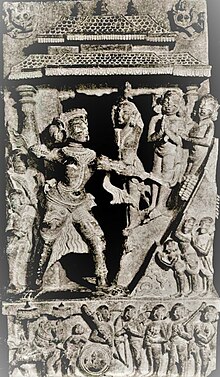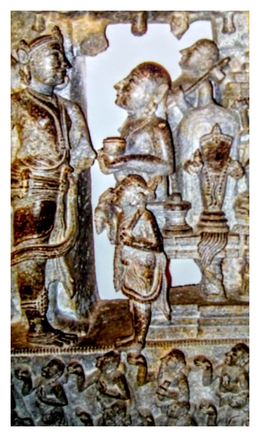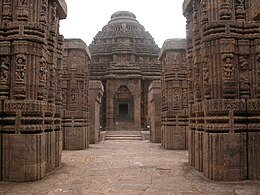
Jagannatha is a deity worshipped in regional Hindu traditions in India as part of a triad along with his (Krishna's) brother Balabhadra, and sister, Subhadra. Jagannath, within Odia Hinduism, is the supreme god, Purushottama, and the Para Brahman. To most Vaishnava Hindus, particularly the Krishnaites, Jagannath is an abstract representation of Krishna, or Vishnu, sometimes as the avatar of Krishna or Vishnu. To some Shaiva and Shakta Hindus, he is a symmetry-filled tantric form of Bhairava, a fierce manifestation of Shiva associated with annihilation.
Kalinga is a historical region of India. It is generally defined as the eastern coastal region between the Ganges and the Godavari rivers, although its boundaries have fluctuated with the territory of its rulers. The core territory of Kalinga now encompasses all of Odisha and some part of northern Andhra Pradesh. At its widest extent, the Kalinga region also included parts of present-day Chhattisgarh, extending up to Amarkantak in the west. In the ancient period it extended until the bank of the Ganges river.
In Odia folklore, Dharmapada was the son of a great architect named Bishu Maharana, who completed the construction of the Sun Temple at Konark, Odisha on the eastern coastline of India, in a single night to save 1,200 craftsmen from execution from the then King Langula Narasingha Deva I. Legends say he sacrificed his own life by jumping into the ocean after carrying out the final step to complete the temple top to prevent the story from spreading. The Konark temple is still standing tall since 13th-century telling Bisu Maharana and his Son Dharmapada's stories.
The Odia (ଓଡ଼ିଆ), formerly spelled Oriya, are an Indo-Aryan ethnic group native to the Indian state of Odisha who speak the Odia language. They constitute a majority in the eastern coastal state, with significant minority populations existing in the neighboring states of Andhra Pradesh, Chhattisgarh, Jharkhand and West Bengal.

The history of Odisha begins in the Lower Paleolithic era, as Acheulian tools dating to the period have been discovered in various places in the region. The early history of Odisha can be traced back to writings found in ancient texts like the Mahabharata, Maha Govinda Sutta and some Puranas. The region was also known to other kingdoms in region of East Indies due to maritime trade relations.

Anangabhima Deva III was an Eastern Ganga monarch who ruled an early medieval Odisha centered empire in eastern India from the year 1211 CE to 1238 CE. He was successful in maintaining a large extent of territory that stretched from the river Ganga in the north to Godavari in the South. He had successfully defeated the Kalachuris on the western frontiers of the empire and established a matrimonial alliance with them. His brother or brother in law, Rajaraja II became the ruler of the Dynasty in 1198. When Anangabhima III came into power, in 1211, he expelled the Muslims of Bengal from his kingdom. He had a son, Narasingha Deva I, who would later invade Bengal in 1244, and captured the capital city, Gauda. He was a reformist in the social and spiritual structure of the Odia society as the vaishnavite deity Jagannath was declared as the supreme ruler of the empire and the emperor as the deputy under him. The Madala Panji records he claiming himself as Shri Purushottama dedicating everything to lord Jagannath. He built the famous Pradaskhina mandapa of Srikurmam temple.
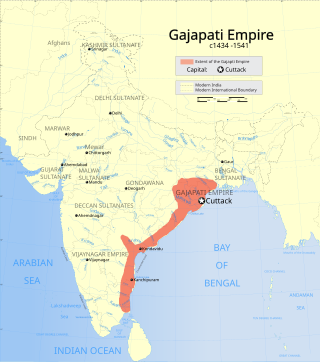
The Gajapati Empire, was an empire established by the Suryavamsa dynasty or Routray dynasty, who were a medieval Hindu dynasty in the Indian subcontinent. It originated in the region of Trikalinga and reigned from 1434 to 1541 CE. It succeeded the reign of the Eastern Gangas. Under the Emperor Kapilendra Deva, the Gajapati empire stretched from lower Ganga in the north to Kaveri in the south.

Shamsuddin Ilyas Shah was the founder of the Sultanate of Bengal and its inaugural Ilyas Shahi dynasty. The Ilyas Shahi Dynasty ruled Bengal for 145 years (1342–1487), except for a 21-year interregnum by the descendants of Raja Ganesha. The Ilyas Shahi rulers are considered to be among the most important political, diplomatic and military leaders of Bengal during the sultanate period. In Bengali history, Ilyas Shah himself has been compared with Alexander the Great because of his ability to conquer large swathes of the Indian subcontinent. Ilyas Shah was instrumental in unifying the principalities of Bengal into a single state.
Western Odisha is the western part of the state of Odisha in India, extending from the Kalahandi district in the south to the Sundargarh district in the north.

The Eastern Ganga dynasty were a large medieval era Indian royal Hindu dynasty that reigned from Kalinga from as early as the 5th century to the mid 20th century. Eastern Gangas ruled much of the modern region of Odisha in three different phases by the passage of time, known as Early Eastern Gangas (493–1077), Imperial Eastern Gangas (1077–1436) and Khemundi Gangas (1436–1947). They are known as "Eastern Gangas" to distinguish them from the Western Gangas who ruled over Karnataka. The territory ruled by the dynasty consisted of the whole of the modern-day Indian state of Odisha, as well as major parts of north Andhra Pradesh, parts of Chhattisgarh and some southern districts of West Bengal. Odia language got official status in their regime following the evolution of the language from Odra Prakrit. The early rulers of the dynasty ruled from Dantapuram; the capital was later moved to Kalinganagara, and ultimately to Kataka and then to Paralakhemundi.
Tughral Tughan Khan, later known as Mughith ad-Din Tughral, was an officer of the Delhi Sultanate. He governed Bengal during 1236-1246 CE and again during 1272-1281 CE.
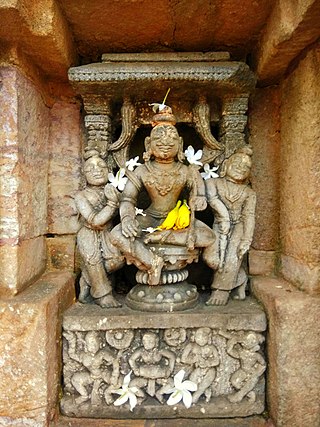
Kapilendra Deva was the founder of the Suryavamsa Gajapati Empire that ruled parts of eastern and southern India with the present-day Odisha as the center of the empire. He ascended to the throne after staging a military coup against the preceding and the last ruler from the Eastern Ganga dynasty, Bhanu Deva IV. He is also referred to as Kapilendra Routray or Sri Sri Kapilendra Deva. Kapilendra claimed descent from the Surya Vamsha of the Mahābhārata and was conferred the regnal title Shri Shri ...(108 times) Gajapati Gaudeshwara NabaKoti Karnata Kalabargeswara i.e. the Lord of Bengal (Gauda), the lord of the Karnataka region or Vijayanagara, the Lord of Kalaburagi and of nine crore subjects.

Vira Pratapa Purushottama Deva was the second Gajapati emperor of Odisha who ruled from 1467 to 1497 C.E. He was the second ruler from the Suryavamsa Gajapati Empire. His father Gajapati Kapilendra Deva Routaraya chose him as his heir to rule the Gajapati Empire at the banks of river Krishna where he breathed his last. This decision infuriated his elder brother Hamvira Deva who was a battle hardened and successful warrior fulfilling the task of conquering the southern territories and expeditions against the Vijayanagara Empire as wished by his father.

Prataparudra Deva was the third Gajapati emperor of Odisha from the Suryavamsa Gajapati Empire founded by his grandfather Kapilendra Deva Routaraya. He reigned from 1497 to 1540 CE. Besides being a monarch, he was a devout Vaishnava and adherent of the famous saint, Sri Chaitanaya who arrived in Odisha during his reign. His life was extremely occupied with overwhelming military campaigns in defense of his inherited territory from three frontal invasions by the enemy states Vijayanagar, Hussain Shahi dynasty of Bengal and Turko-Persian Qutb Shahi dynasty of Golconda. He lost large portions of his territory to the neighboring enemy states initiating the dissolution of Odisha's military hegemony and imperial status that continued for nearly a period of 600 years before him.
Maharaja Sivakara Deva I or Sivakara Unmattasimha/Unamattakeshari was a powerful monarch of the Bhaumakara dynasty who ruled in the late tertiary part of the 8th century A.D. He was the descendant of Ksemankara Deva who is believed to be the founder of the Bhaumakara rule in ancient Odra and also the earliest organizer of the Varna system in the region. Sivakara Deva I pursued a career of conquest in the eastern part of India establishing the Bhaumakaras as the supreme power in the whole region during his lifetime. According to the Talcher plate of Sivakaradeva III, Sivakaradeva I alias Unmattasimha defeated the king of Radha(south-West Bengal). When Unmattasimha was ruling in Orissa, Bengal was still in a state of disorder, and therefore the Radha king defeated by him can not be identified. However, Sivakara I either started ruling from 756 CE or 786 CE. He subjugated the Eastern Ganga rulers of Kalinga as his vassals. His dominions stretched from the border of Bengal in the north to the river Godavari in the south. He was a devout Buddhist who in 790 built the Sholampura Buddha Vihara and who adopted the epithets of Paramopasaka and Paramatathgata meaning a devout worshiper of Buddha which has been mentioned in the Neulpur charter of the Bhaumakaras. He sent a Buddhist scholar as an emissary to the Chinese emperor Te-tsong or Dezong with valuable Mahayana Buddhist manuscripts and established a new era of maritime trade and cultural relationship between ancient Odisha and China.

The Bhoi dynasty or the Yaduvamsa dynasty were a medieval Hindu dynasty from the Indian subcontinent, which originated in the region of Odisha that reigned from 1541 to 1560 CE. Govinda Vidyadhara had usurped the throne from the later weaker Suryavamsa Gajapati Empire rulers as the kingdom started weakening but had a short-lived reign as ruling chiefs of Odisha as the ensuing internal rivalries and constant threats of invasions rendered them weak and were eventually overthrown by Mukunda Deva of Chalukya dynasty in 1560.
The Battle of Katasin was fought in 1243 CE between Narasingha Deva I of the Eastern Ganga dynasty and Tughral Tughan Khan, the Bengal governor of the Mamluk dynasty of Delhi, at Katasin. Narasingha Deva I delivered a crushing defeat to the Mamluk forces and subsequently went on to capture additional territory.
Gajapati is a regnal title from the region of modern Odisha in the Indian subcontinent. The word ‘Gajapati’ in Odia refers to "Gaja" meaning elephant and "Pati" meaning master or husband. Thus Gajapati etymologically means a king with an army of elephants. The institution of Gajapati kingship as a title was used by the Eastern Ganga dynasty and was used by succeeding dynasties, with the patronisation of Lord Jagannatha as the imperial deity of the Odia cultural realm.
The Bengal sultanate conquest of Orissa in 1568 was a military campaign led by the Karrani dynasty of the Bengal Sultanate under Sulaiman Khan Karrani. The objective was to overthrow the Chalukyan rule of Orissa under Mukunda Deva and the Bhoi rule under Ramachandra Deva I. The Bengal forces achieved victory, resulting in the annexation of Odisha into the Sultanate. Odisha remained part of the Bengal Sultanate until its eventual annexation by the Mughal Empire.
